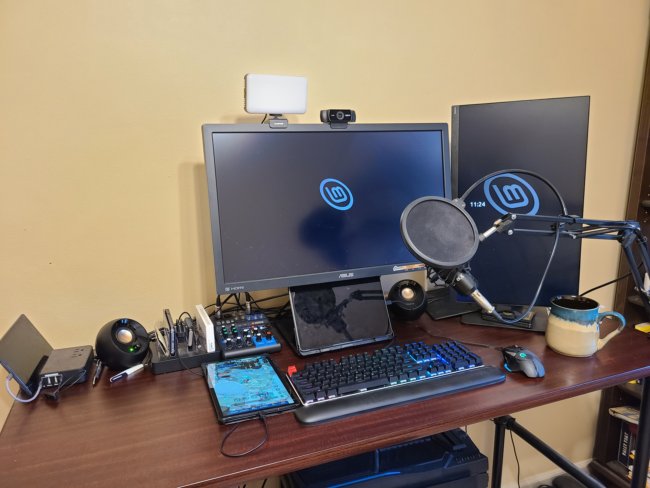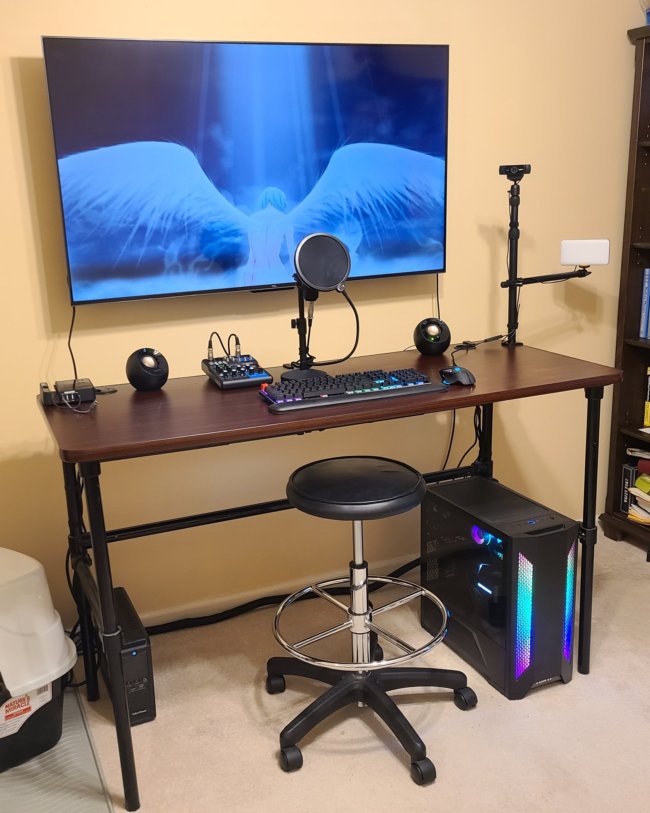Visually Repaired
So I already noted in my previous post that my Macular Degeneration had returned. I hated to admit it at the time, but it meant finally doing what I’d been putting off since this whole adventure began. I had to prepare myself for potentially slowly going blind. My existing desk situation was going to have to change.

Goodbye old friend
Getting Carded
Given that I work with computers all day, I knew that meant I needed to replace two things: my monitor, and possibly my video card. One of my first ideas was to buy a 4K TV and mount it to the wall. A 4K TV is the same real-estate as four 27-inch 1080p monitors. Given I was already using a 27-inch 1440p monitor, that would be a rather dramatic increase in visual area. I could comfortably magnify everything considerably and still have greater overall space.
But there was a tiny impediment. I did some consulting for a company about eight years ago, and they paid me back by sending an EVGA GTX 980 Ti SC. It was basically the best GPU available at the time. But it has been eight years since then, and I’ve noticed modern games in my collection struggling considerably. The reason? Video RAM. Even on low settings, many new games are both insufficiently optimized but also use larger textures, resulting in slide-shows rather than smooth gaming. As powerful as the 980 Ti may still be, it’s hobbled tremendously by having only 6GB of VRAM.
Knowing that, I searched for new and used cards with more RAM and could handle modern games. I don’t play as much anymore, but it’s a good indicator for the longevity of the hardware and its ability to drive a 4K TV. My first choice after a bit of research was an AMD Radeon 6800 XT. It boasts over 2x the performance stats of the 980 Ti and since it’s a last generation card in ready supply, is available for a semi-reasonable price. Heck, at the time I was looking, AMD was even running a promotion where they were including Starfield with certain cards.
I was literally seconds away from purchasing one when I chanced across a thorough breakdown of video cards and AI performance by Tom’s Hardware. It turns out Nvidia maintains what amounts to a stranglehold on AI thanks to their CUDA and Tesla core technologies. AMD is trying to catch up with ROCm, but they’re way behind, and much harder to use thanks to the proliferation of CUDA-focused tools.
It’s no secret I’m a fan of Stable Diffusion, and the prospect of jumping through a bunch of extra hoops and still getting worse performance was a deal breaker. The problem is that AMD cards ship with way more VRAM than competing Nvidia offerings. AI loves VRAM, and like Stable Diffusion, large language models operate much better with a surplus. So if I wanted to run a local LLM and not wait a billion years while my CPU churned up a response, that meant a GPU with 16GB of RAM or more. Why 16 and not 12? Future-proofing. If mid-tier last-generation AMD cards already had 16GB, there’s no reason to expect newer cards to have less.
But that’s exactly what they did have. With AMD out of the running, all Nvidia cards except for literally the top end ship with 12GB of RAM. Why, Nvidia? Given I flatly refuse to pay $1200-$1200 for a RTX 4080 or 4090, that meant going back a generation to the 30-series. And sigh, of course the 3080 only shipped with a maximum of 12GB VRAM. Of course. But the 3090? 24GB! No middle ground for these psychopaths, apparently.
So I scoured the internet for a used 3090 that wouldn’t cost a house payment. If I didn’t live out in the sticks, I could have spent as little as $600 through Facebook Marketplace. Still, I managed to procure a clean and stable RTX 3090 Founders Edition complete with retail box for $650 on eBay, less than half the original MSRP. It’s the first video card I’ve paid for in over a decade, and given the specs, it should last at least as long as my 980 Ti.
Unfortunately the 3090 is also notoriously power-hungry, using about 100W more than the 980 Ti on average while under load. My existing EVGA G3 650W power supply would probably not be enough, and Nvidia themselves recommend a 750W unit. So I scoured the net a bit more and settled on a Corsair RM850x. The RM-series scores well on the PSU tier list and it was on sale. My older EVGA survived through three builds because I over-provisioned slightly, so I’m hoping an 850W will have similar longevity.
Huge Tracts of Land
Which brings me to the TV. I actually bought that first during the Amazon Prime Day sale last month. Yes this was before my MD reemerged, but it’s always been at the back of my mind. I’ve been looking at TVs for a while now, weighing the benefits of using a 4K TV as a monitor, whether or not to risk OLED burn-in, and so on. YouTube kept recommending topical content in that area, and I kept watching it to stay apprised of my options.
Without the urgency of my MD coming back, I mostly just browsed reviews of various TVs that looked like they were a good deal. I still wasn’t “sold” on the idea, and it wasn’t until literally the last hour of Prime Day that I finally relented and pulled the trigger. I settled on a 55-inch TCL Q7 .
The early reviews of it were spectacular, including from the infamous Stop the FOMO review channel performing a 4-hour exhaustive comparison with similar models. It was (and currently is) available for $550, which is criminally low for what appears to be one of the best 55-inch non-OLED panels available. I waited too long for current stock, so the TV wouldn’t arrive until the beginning of August. But that was fine; I was in no hurry—yet.
I decided against OLED due to my fear of burn-in. My primary use cases would be as a workstation, meaning lots of window title-bars and other static elements which would encourage image retention. I want this thing to last as long as possible, and until OLED can solve that problem permanently, it isn’t a risk I’m willing to take. I’ll definitely consider it when we replace one of our other two TVs, but they’re still working just fine.
I included a wall-mount with the purchase for obvious reasons. Despite the fact the TV itself would fit on my desk, that would increase its proximity to my face substantially. Even the wall itself wasn’t far enough away, and I’d have to pull my desk out at least another six inches. I’m trying to address my bad eyesight after all, not exacerbate the situation. Plus, my desk will be much less crowded without two monitors. Well, until the kitties figure out they can fill the newly vacant space.
Odds and Ends
So my plan was slowly coming together. I had a TV on the way, a suitable video card in transit, the necessary PSU arriving soon, and… wait a minute. Where would I put the webcam? Uh oh.
Webcams usually go on top of monitors. That’s not a problem with a 27-inch monitor, but a 55-inch mounted to the wall? Even after angling it downwards, the view would be incredibly awkward and weird, so I started looking for another solution. I finally ran across a desk clamp that would allow me to mount the camera to a telescoping pole for any suitable height. It even had an extra mount for my indirect lighting.
With the “monitor” centered over my desk, I also decided that a mic stand would be a better option than the swing arm I’d been using. The arm extends pretty far, but it also covers half the desk when in use, and then blocks the bookcase when swung away. While I was at it, I figured I’d clean up my cable management, so I included an actual under-desk tray for any necessary power strips, stray cables, and so on. A cable loom wouldn’t hurt either, so into the cart it went.
That seemed to be everything, so it all became a waiting game.
Bringing it Together
The first thing to arrive was actually the TV, but I couldn’t do anything with it until I had a spare weekend to mount the thing. The power supply came next, and was the perfect short-term project, as it allowed me to extricate the old EVGA G3 and introduce the Corsair. I plugged in all the modular cables I’d need, reassembled the computer, and made sure everything was working.
The video card was the missing ingredient, and it came last. I’ll admit I was a bit nervous about introducing some random eBay component into my build, but the card was clean, came with a retail box, and didn’t appear damaged. It worked perfectly, and I even ran it through some Stable Diffusion generations to make sure it wouldn’t crash under load or cause weird video glitching. Not only did it pass, but this thing is at least three times faster than the 980 Ti. Beyond that, a couple games I had that were stuttering horribly on low settings at 720p were suddenly just fine on maximum at 4k.
Now… a 980 Ti should have been OK to run even modern games at low settings at 30 FPS, but I’m also using Linux, meaning games are actually operating through Proton in most cases. The overhead of that combined with poorly optimized code and unnecessarily large textures mean that some games are 5-10 FPS slideshows on a 980 Ti with its paltry 6GB of VRAM. Not so with the 3090 and its much roomier 24GB. At least for now.
In any case, the last thing to install was the TV. I dutifully measured my line of sight for the middle of the TV and lowered it a bit just in case. I figured it might sit high, and while it was good to have some space under the monitor to prevent blocking it with desktop items, I didn’t want to strain my neck. Installing the wall mount and TV were both surprisingly quick and easy. I actually spent far more time tearing apart my desk and getting it out of the way, and then re-wiring and assembling everything once more. My only regret is that the wall studs weren’t properly aligned to keep my desk in its old position, so I had to shift it about eight inches to the left.
I’d say the final result was worth it, though. Theoretically I could also ditch the external speakers since the TV sounds fine by itself, but I’ll keep ’em for now.

So much room for activities!
Once the TV was updated and properly set to the computer HDMI feed, that was mostly the end of things. I configured the display settings to 125% scaling, increased some default font sizes, and I was done. I ran into a bit of trouble with the RXVT terminal I use because the Terminus font I chose wouldn’t go above 32-points. Thankfully NotoMono worked out better, and now my consoles are crystal clear as well. I gotta say, 16-point fonts on a 55-inch display are tiny!
And that’s the story of how I finally managed to Ship of Theseus my computer. The EVGA PSU and 27-inch monitor survived three systems, and the 980 Ti found itself in two. Now there isn’t a single part from any of my old systems in the current build, and it only took 11 years.
Until Tomorrow
